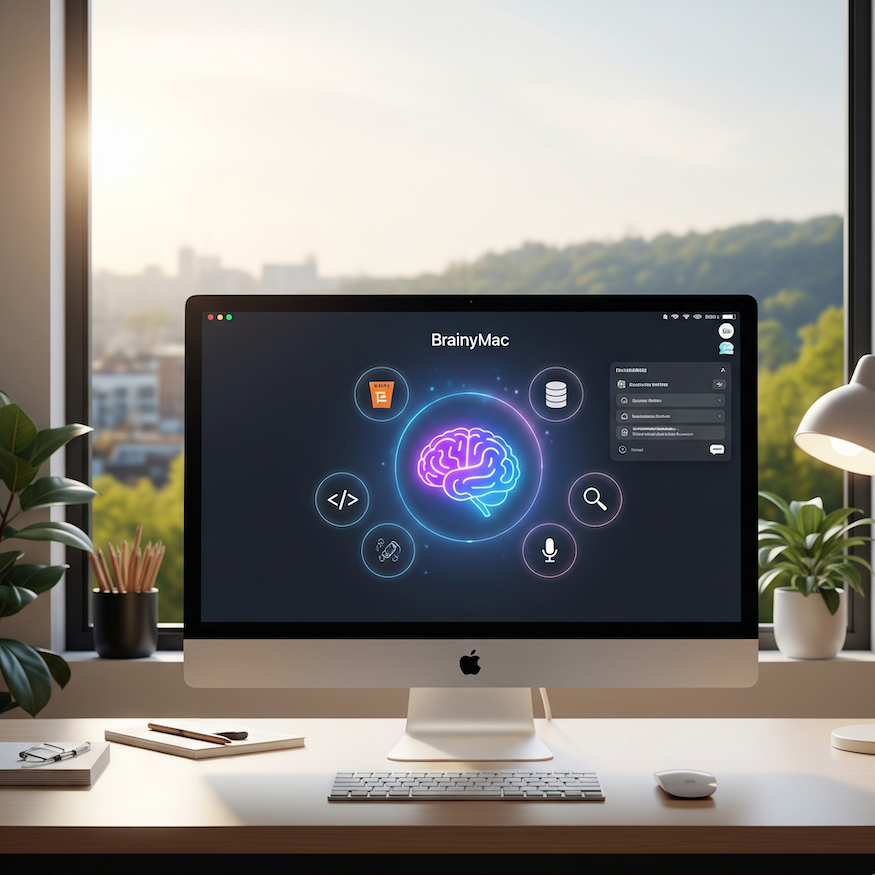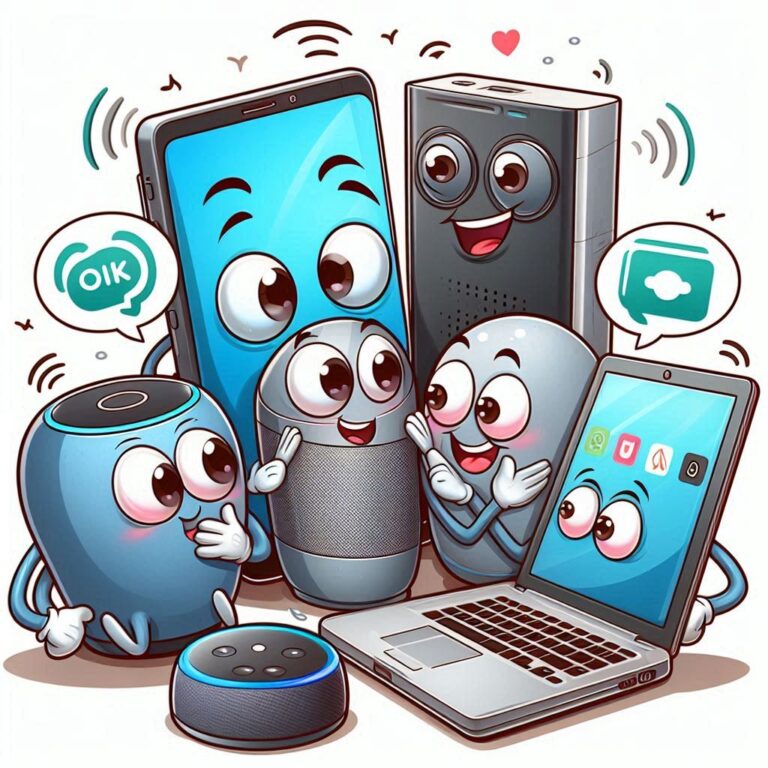The BrainyMac Concept: Redefining Productivity with AI on Apple
You know those ideas that just cling to your brain like a stubborn limpet for days, refusing to let go until you write them down? Well, I’ve had one rattling around in my noggin for a while now, and it involves a Mac, some seriously clever AI, and a whole heap of ‘what if?’ My poor brain, bless its cotton socks, decided to conjure up a hypothetical app that’s a bit like LM Studio had a love child with Google Gems, and then WordPress decided to be the eccentric godparent, insisting on a snazzy GUI and a “skills store.”
Sounds a bit bonkers, right? Perhaps, but hear me out. Imagine having a graphical interface on your Mac that lets you chat with an LLM, but here’s the kicker: it’s not just a general-purpose guru. Instead, you’ve got a lean, mean base LLM that handles the chit-chat (think of it like using Alpine Linux as a base for a Docker container), and then there’s an actual App Store (or ‘Skills Store,’ if you’re feeling fancy) where you can download specific AI skills. Need to code a website? Enable the HTML, PHP, CSS, JavaScript, and maybe even a MariaDB skill. Suddenly, your AI sidekick isn’t trying to do everything at once; it’s focused, efficient, and ready to help you design that site using plain old natural language.
My thought process for this little brainwave was pretty straightforward: it would allow developers to craft highly specialized skills, focusing on the important details rather than trying to make a one-size-fits-all model. And for us end-users? Well, only enabling the skills we actually need could mean a system with less resource hogging and, potentially, a much better, more tailored end product. Plus, my base model M4 Mac Mini could probably breathe a sigh of relief!
Decoding the Jargon: What Exactly is an LLM, Anyway?
Alright, before we dive deeper into my Mac-centric AI dream, let’s hit pause for a quick, jargon-free chat about what an LLM actually is. Because if you’re not knee-deep in the tech world (and let’s be honest, who has the time to be thatdeep?), these acronyms can start to feel like a secret code only understood by folks with multiple monitors and an unhealthy obsession with RGB lighting (I’m feel a bit judged… by myself).
LLM stands for Large Language Model. Easy, right? Now for the slightly less easy bit: what do they do? Essentially, think of an LLM as an incredibly sophisticated, super-powered text prediction machine. Imagine your phone’s autocomplete, but it’s gone to Oxford, read every book, article, and tweet ever published, and then decided it wants to be a poet, a programmer, or even a philosopher. It’s been trained on colossal amounts of text data – we’re talking trillions of words here – and because of that, it’s learned patterns, grammar, facts, and even nuances of human conversation.
So, when you type a prompt into an LLM, it’s not “thinking” in the human sense (my brain also starts to fog over trying to truly grasp that concept, so don’t worry if yours does too!). Instead, it’s predicting the most statistically probable next sequence of words based on all the data it’s devoured. It’s like a digital librarian, but instead of just finding you a book, it can write a new one for you on the spot, perfectly mimicking the style of anything it’s ever read. Pretty wild, isn’t it? They’re becoming the Swiss Army knife of the digital age, capable of everything from drafting emails to brainstorming blog post ideas (yes, meta, I know!).
But here’s where it gets even more interesting, especially for my app idea: sometimes these incredibly smart models need a little help remembering specific things or knowing about current events, because their training data might be a bit old. That’s where RAG (Retrieval Augmented Generation) swoops in like a superhero. Think of RAG as giving our super-librarian a magic tablet connected to Google. When you ask a question, the LLM first looks up relevant information from a specific database or set of documents (that’s the “Retrieval” part), and then it uses that fresh info to help formulate its answer (the “Generation” part). It’s how these models can give you up-to-date or highly specific answers without having to be completely retrained every Tuesday. Crucial for keeping your AI brain accurate and relevant, especially if we’re talking about specific coding standards or the latest tech specs.
Now, you might have heard me mention Google Gems in the intro. What are they? Well, essentially, they’re custom versions of Google’s Gemini AI, allowing you to tailor the AI’s persona and knowledge for specific tasks. Imagine saying, “Hey Google, be my expert chef for this conversation,” or “Okay, now you’re my super-smart coding assistant.” It’s like giving the AI a job description and a personality for a particular chat. And not only that you can provide it with up to 10 documents to help guide it to be things a series of manuals for products or a boat load of your old blog posts so you can chat with your website. This concept of specialised AI roles is a big inspiration for my “skills store” idea.
And then there’s WordPress and App Stores. I know, you’re probably thinking, “Jim, what do a blogging platform and your phone’s app shop have to do with LLMs?” Well, they’re brilliant examples of user-friendly platforms with vast ecosystems. WordPress democratized website creation by offering a simple GUI and a massive plugin library. The App Store made powerful software easily discoverable and installable for everyone. These are the user experience benchmarks – making complex tech accessible, intuitive, and expandable – that I’m dreaming of for a local LLM app. We want that same effortless discovery and integration, but for AI capabilities.
My Mac’s Inner Genius: Why Local LLMs are the Future (and Your Privacy’s Best Friend… and Your Wallet’s! )
Alright, so we’ve established what an LLM is, and why my brain decided to mash it up with an App Store and WordPress. But you might be thinking, “Jim, why bother running these things on my own Mac when I can just use a cloud service?” And that, my friend, is where the magic (and a good chunk of the why) truly happens. Because as someone who’s often tinkering with various tech setups (and occasionally breaking them, much to my family’s amusement), the idea of keeping my AI interactions local really appeals.
First up, let’s talk Privacy. This is a biggie, folks. When you’re chatting with a cloud-based LLM, your data – your prompts, your questions, your entire conversation – is being sent off to a server somewhere out there in the digital ether. Who’s seeing it? How long is it stored? What’s happening to it? These are questions that, frankly, can give my privacy-sensitive heart a bit of a flutter. With a local LLM, that data never leaves your machine. It’s like having a highly intelligent, confidential assistant sitting right there on your desk, whispering secrets only to you. For sensitive projects, personal brainstorming, or just generally keeping your digital life, well, yours, this is an absolute game-changer. No more sending your brilliant (or hilariously terrible) ideas off to the cloud to be processed and potentially, eventually, maybe, perhaps, used for who knows what.
Then there’s Speed. Oh, the glorious speed! While cloud LLMs are getting faster, there’s always that tiny bit of latency as your request travels to a data center and back. With a local LLM leveraging your Mac’s built-in neural engines (those M-series chips aren’t just for looking pretty, you know!), the processing happens right there, on-device. It’s almost instantaneous. Think about it: no more waiting for a server farm halfway across the world to crunch your query. It’s like having a super-powered brain on your desk that doesn’t need to phone home to ask permission every five seconds. For iterative tasks, brainstorming on the fly, or just when you’re in that creative flow, this near-zero latency is a massive productivity booster. My M4 Mac Mini (the base model, remember? Still a beast!) could probably handle a surprising amount of heavy lifting without breaking a sweat, which is a testament to Apple Silicon’s design.
And now, for the part that really hits home for many of us: Cost (or rather, lack of it!). This is a point often overlooked until your bill arrives, tighter than my jeans after Christmas dinner. I recently tried to jump into a competition with Bolt.new, and they generously gave a free month’s subscription to their pro plan. Sounds great, right? Well, I managed to burn through all the credits in a day and a half! That would have set me back a cool $20 a month, and if I’d wanted to finish the app I was coding, I would have had to pony up even more cash. Ouch. Cloud-based LLMs, especially the powerful ones, can chew through credits faster than a toddler with a packet of biscuits (and believe me I know, I never did get any of my last back of triple chocolate Fox’s biscuits). When you’re developing, experimenting, or just plain using AI extensively, those monthly fees can add up quicker than you can say “large language model.”
And it’s not just the direct cost. Take services like Google’s Firebase Studio – fantastic for certain things, but currently, their no-code prototyper primarily supports TypeScript apps. Great for web, not so much if you’re trying to spin up a native app for macOS, iOS, or even something bespoke. These kinds of limitations, coupled with the recurring costs, really highlight why having something powerful and flexible on your own machine, without a per-token meter running, is a far more appealing (and wallet-friendly!) prospect.
Finally, let’s throw in a little something for the eco-conscious among us: Efficiency (and a dash of Green Tech). While a single local LLM might not change the world, collectively, reducing our reliance on massive, always-on data centers that consume enormous amounts of power for every single AI interaction does make a difference. By processing on-device, especially with the energy-efficient neural engines in modern Macs (and other local GPUs/TPUs for the non-Mac crowd, because we’re inclusive here!), we’re potentially contributing to a slightly greener digital footprint. It’s a small step, perhaps, but every little helps, right?
So, whether it’s for keeping your ideas under lock and key, getting lightning-fast responses, keeping your bank account happy, or just feeling a little better about your tech’s environmental impact, running LLMs locally is a compelling proposition.
Diving into the Deep End: What LM Studio and Ollama Do Well (and Where We Still Dream)
Now, I’m not here to suggest that running LLMs locally is some entirely uncharted territory. Far from it! There are already some truly fantastic tools out there that let you download and run these powerful models right on your machine, often leveraging the very same Apple Silicon neural engines we’re so fond of. The two big players you’ll often hear about, and that I’ve definitely spent some quality (and occasionally frustrating) time with, are LM Studio and Ollama. Bless their open-source-loving souls.
LM Studio is a bit of a graphical powerhouse. It gives you a nice, clean interface where you can browse a vast library of models (often hosted on Hugging Face), download them with a few clicks, and then run them right there. It’s got a chat interface, it’s fairly intuitive, and for many, it’s been their first delightful dip into the world of local AI. It’s genuinely impressive how accessible it makes what could otherwise be a very daunting process, particularly given how well it hooks into things like Apple MLX for those sweet, sweet on-device performance gains.
Then there’s Ollama. This one’s a bit more command-line friendly (though it does have some fantastic web UIs built on top of it by the community). Ollama simplifies the process of pulling models and running them with simple commands, and it’s become a go-to for many developers and tinkerers who want a robust, lightweight way to manage their local LLMs. It’s super efficient and, once you get the hang of it, incredibly powerful for deploying models.
So, they’re great, right? And they absolutely are. But here’s where my little brain starts to itch, much like when I’m trying to find that one specific screwdriver in a toolbox filled with everything but the right size. While both LM Studio and Ollama excel at getting you up and running with a general-purpose LLM, they’re not really designed for that modular, “App Store for AI brains” vision I’m harping on about.
For instance, if I want to switch from a coding-focused model to one that’s better for creative writing, I often have to actively download and load a new, entirely separate model. There isn’t a seamless, GUI-driven way to “enable” or “disable” specific capabilities like an HTML generation “skill” or a “MariaDB schema designer” skill. It’s more about swapping out the entire brain, rather than adding a specialized lobe. My initial attempts at getting everything humming smoothly were like trying to get a two-year-old to put their socks on when all they want to do is run around like the Tasmanian devil on a sugar high, and while I got there in the end, that friction is what I’m hoping to eliminate for the average user.
They’re brilliant tools for where we are right now, pushing the boundaries of local AI (and showcasing the power of things like Apple MLX!), but they also serve as a perfect jumping-off point to imagine what’s next: a more integrated, user-friendly, and modular approach to harnessing the power of these incredible models, specifically tailored to the task at hand.
The “App Store for AI Brains”: Bringing the Dream to Life (Theoretically Speaking, Of Course!)
Alright, we’ve talked about what LLMs are, why running them locally on our Macs (and other machines) makes so much sense, and even peeked at the current tools available. Now, let’s dive headfirst into the truly exciting bit: my big, hairy, audacious idea for what comes next.
Before I lay it all out, a very important caveat: I am not a programmer. Like, at all. My coding skills are roughly on par with a hamster trying to solve a Rubik’s Cube – enthusiastic, but ultimately… not very successful. So, whether this whole concept is even possible is something I have absolutely no idea about. I also fully grasp that this would fundamentally change the way developers approach and produce LLMs, meaning it’s a massive conceptual leap, not just a small hop. But hey, that’s why it’s an idea rattling around in my head, a dream for the future, rather than something I’m diving into headfirst with a GitHub repo already open! Consider this less of a technical whitepaper and more of a “wouldn’t it be cool if…” brainstorm.
So, picture this: You boot up your Mac, and instead of wrestling with command lines or navigating complex model libraries, you open an app. Let’s call it “BrainyMac” (I’m still workshopping names, obviously, my marketing department is currently a solitary cat). This app presents you with a beautiful, intuitive Graphical User Interface (GUI) – think Apple simplicity meets, well, my brain’s desire for things to just work.
At its core, this app would house a relatively small, general-purpose base LLM. This isn’t your do-everything, answer-all-questions behemoth. Think of it as the friendly receptionist of your AI world. It handles the basic chat interaction, understands your initial queries, and acts as the gateway to the real power. It’s lean, efficient, and lives permanently on your machine, always ready for a chat, without hogging all your precious RAM or neural engine cycles.
Now for the truly revolutionary part: the Skills Store. Imagine an interface that looks and feels just like the Mac App Store, but instead of downloading photo editors or games, you’re downloading specialized AI skills. These skills would essentially be highly focused, smaller LLMs (or modules that augment the base LLM) designed for specific tasks.
Let’s say you’re building a website, and you need some HTML. You’d simply browse the “Coding” category in the Skills Store, find an “HTML & CSS Generator” skill, and with a single click, it’s downloaded and ready to go. Then, because your project also involves a database, you might add a “MariaDB Schema Designer” skill. Suddenly, your base LLM (our friendly receptionist) has access to these specialized “experts” as needed. You could then chat naturally: “Okay, BrainyMac, I need a three-column layout for a new blog post page, include a header and a footer,” and the HTML skill would kick in, providing the code. “Now, design a database schema for my user profiles, including fields for username, email, and password (hashed, of course!),” and the MariaDB skill would respond.
This modularity is the real game-changer. It means developers can focus on building incredibly precise, high-quality skills for narrow use cases, rather than trying to make one giant LLM master everything. This could lead to more accurate, reliable, and innovative AI tools, because if you’re not trying to be all things to all people, you can really nail the specifics. And for us, the users? It’s a dream for resource efficiency. You only load the “brains” you need. No more general-purpose LLM hogging gigabytes of VRAM if all you want is to generate a few lines of Python. Your Mac (or PC, or Linux box with TPUs/GPUs) only spins up the necessary neural engine power for the specific skill in use. My base model M4 Mac Mini would be doing cartwheels! It also makes the whole user experience dramatically simpler – no more complex model management, just a familiar app store interface to get the AI power you need, when you need it.
And here’s where we layer on another level of genius, directly inspired by things like Google Gems: Your Own Personal AI Brains. Beyond the developer-created skills, you, the end-user, could create and manage your own custom “brains” or “personas” within the app. Imagine setting up a “Snarky British Comedian” brain with a set of specific instructions on tone and style. Or a “Cybersecurity Analyst” brain that’s told to always prioritize security implications. Crucially, you could feed these custom brains your own documents. Want to chat with your website’s entire knowledge base (including all your old blog posts, bless their digital hearts!)? Just feed it in. Got a series of product manuals you need help navigating? Upload them, create a “Product Manual Expert” brain, and guide the LLM exactly how you want it to operate. This is where our RAG discussion from earlier really comes into play. The base LLM acts as the orchestrator, intelligently using RAG to pull information from the relevant skill’s knowledge base and your own custom document sets before generating its response. It’s like calling upon the right expert with their own specialized library and then handing them your specific notes too, rather than hoping a generalist remembers every minute detail. The power to truly personalize and guide your AI assistant would be phenomenal.
Beyond the Basics: BrainyMac in Action and the Community Dream
So, we’ve sketched out the bones of BrainyMac, with its lean base LLM and that shiny Skills Store. But what does this actually look like in practice? How would this theoretical marvel change your day-to-day creative and productive life? Let’s wander down a few hypothetical paths, shall we, and imagine a world where AI truly bends to your will, not the other way around.
Take, for instance, a budding fantasy novelist (maybe me, on a particularly ambitious Tuesday). Right now, the journey from a flickering idea to a full-blown world involves endless notes, scattered documents, and a desperate plea to Google when you forget the precise lineage of your elves. With BrainyMac, imagine downloading a “World-Building Skill” that understands complex fantasy tropes, or a “Character Development Skill” that helps you craft intricate backstories. You’d feed it your own scribbled notes, maps, and character sketches into a custom “Fantasy Lore” brain you’ve created. Then you could chat: “BrainyMac, I need a detailed history of the Crystal Peaks, including their magical properties and the ancient civilizations that once lived there,” and boom – an instant, consistent, and contextually rich response, drawing on the skill’s knowledge and your provided lore. No more conflicting dates or forgotten spell names!
Or what about the perpetually-overwhelmed student (which, let’s face it, is most of us at some point)? Picture them grappling with a complex physics problem. Instead of trawling through textbooks or YouTube rabbit holes, they could enable a “Physics Tutor Skill.” They’d feed it their lecture notes, maybe even some tricky homework questions, into a “My Physics Class” custom brain. They could then ask questions in natural language, dissecting concepts, getting step-by-step solutions, and even having the AI grade practice essays using an “Essay Grader Skill.” The AI isn’t just giving answers; it’s teaching, personalized to their learning materials, all without a monthly subscription meter ticking away. The thought alone makes my brain feel less foggy, and my back is grateful for not having to carry so many textbooks!
Even for something like managing your digital life, imagine a “Digital Declutter Skill” that helps you organize your files based on content, or a “Meeting Minute Summarizer” that takes your messy notes and spits out concise action points. The beauty is that these skills would be so specialized, so focused, they’d likely be incredibly good at their one job, unlike a general-purpose LLM trying to wear all hats at once.
And this leads me to another exciting thought, something that’s simmering on the horizon: agentic capabilities. While BrainyMac, in my current vision, is about chatting with specialized AI brains, the next logical step (and something I’d love to dive into in a future post, perhaps!) is for these skills to actually interact with your computer. Imagine asking your “HTML & CSS Generator” skill not just to give you the code, but to open your code editor and paste it directlyinto a new file. Or having your “Digital Declutter Skill” not just suggest organizing files, but actually moving them for you based on your instructions. It’s giving the AI a pair of hands to operate your software, taking automation to a whole new level. Mind-blowing, isn’t it?
And this deep functionality brings us perfectly into the grander vision: the BrainyMac Ecosystem and Community Dream. Because if developers are creating these incredible, focused skills (and perhaps even agentic ones!), and users are creating their own custom brains, wouldn’t it be amazing if we could share them? Imagine a curated section of the Skills Store where users can upload and share their custom-built “brains” – perhaps a “Recipe Adjuster” brain complete with family dietary restrictions and preferred cooking methods, or a “Local History Buff” brain loaded with fascinating facts about Bridlington.
This isn’t just about downloading software; it’s about building a living, breathing community. Think of it like the WordPress plugin ecosystem, but for AI intelligence. You could browse user reviews, see ratings for how effective a “skill” or “community brain” is, and find niche solutions to problems you didn’t even know AI could solve. Developers could even offer premium skills, creating a vibrant marketplace where innovation is rewarded. Imagine the kind of highly specialized, incredibly effective AI tools that could emerge when talented individuals are empowered to focus on perfecting one “brain” or “skill,” rather than attempting to build a universal genius. It turns AI development into something much more collaborative and community-driven, moving us beyond monolithic models to a diverse, adaptable, and truly personalized AI future.
Why This Crazy Idea Actually Matters (And What Do You Reckon?)
So, we’ve journeyed through the winding paths of my brain, from the initial spark of an idea to a detailed vision of BrainyMac, complete with its Skills Store, custom brains, and even a speculative nod to agentic capabilities. We’ve talked about privacy, speed, cost savings (which, let’s be honest, is a huge win!), and the sheer potential for hyper-specialized AI that just works for you.
But beyond the technical elegance and the shiny GUI, why does this idea, this seemingly audacious leap, truly matter? For me, it boils down to two core things: Empowerment and Evolution.
It’s about Empowering the user. Instead of being passive recipients of generic, cloud-based AI, you become the orchestrator. You choose the skills, you define the personas, you provide the context. It shifts the power dynamic, putting control firmly back into the hands of the creator, the developer, the student, the everyday user. It means AI becomes a truly personal assistant, tailored not just to your needs, but to your way of working and thinking. Imagine the creative freedom when your AI companion is truly yours, operating on your terms, locally, and without a constant meter running.
And it’s about the Evolution of AI development. If this kind of modular, skill-based approach gains traction, it could foster an incredible ecosystem of innovation. Developers could focus on crafting incredibly sharp, niche AI tools, perfecting a single “skill” rather than trying to build a universal model that’s a jack of all trades and master of none. This shift could lead to a proliferation of highly effective, specialized AI solutions that solve real-world problems with precision and efficiency. It could democratize AI creation, bringing more diverse minds into the fold, and ultimately push the boundaries of what these amazing models can do, right there on your desktop.
It’s a big vision, I know, and one that perhaps requires a few leaps of faith (and quite possibly, some genuine programming genius that I definitely don’t possess!). But if we’ve learned anything from the rapid ascent of AI, it’s that yesterday’s impossibility is often tomorrow’s standard feature. And building AI that is personal, private, powerful, and truly yours feels like a future worth dreaming about.
So, what do you reckon? Am I onto something here, or have I spent too much time talking to my smart home devices? What “skills” would you be downloading first for your own personal AI assistant, and what custom “brains” would you be building? Let’s get the conversation going! Drop a comment on the social post that brought you here, or if you not all that into the socials send me a message using the contact for link at the top of the page.







